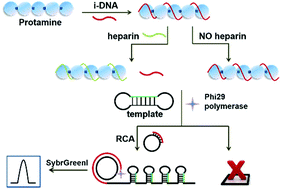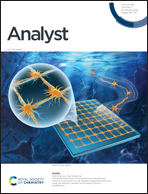A rolling circle amplification based platform for ultrasensitive detection of heparin
Abstract
Heparin has a variety of pharmacological uses, including applications for anti-tumor metastasis, anti-inflammatory and anti-viral activities and is widely used as a clinical anticoagulant. Due to its widespread applications in the clinical procedures, monitoring heparin levels is critically important to ensure the safe use of heparin and to prevent overdose and complications, such as hemorrhage and thrombocytopenia. However, traditional heparin detection relies on the measurements of the activated clotting time or activated partial thromboplastin time, which are not sufficiently reliable or accurate measurements for certain clinical settings. In this work, we describe a dumbbell probe-aided strategy for ultrasensitive and isothermal detection of heparin based on a uniquely strong protamine–heparin interaction and rolling circle amplification driven signal amplification. The detection limit for heparin is 12.5 ng mL−1 (0.83 nM), which is much lower than the therapeutic level of heparin in cardiovascular surgery (17–67 μM) and in postoperative and long-term treatment (1.7–10 μM). Additionally, the proposed sensing platform works well for heparin monitoring in human plasma samples. This simple and ultrasensitive heparin biosensor has potential application in diagnostics, therapeutics, and in biological research.



 Please wait while we load your content...
Please wait while we load your content...